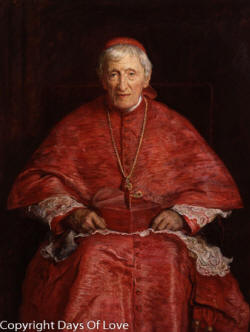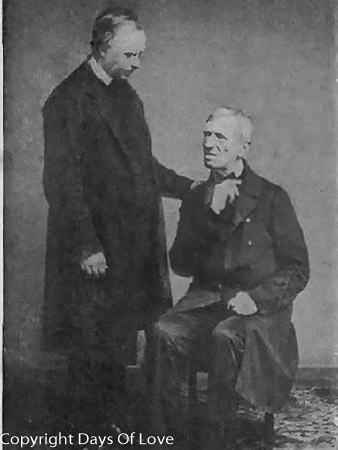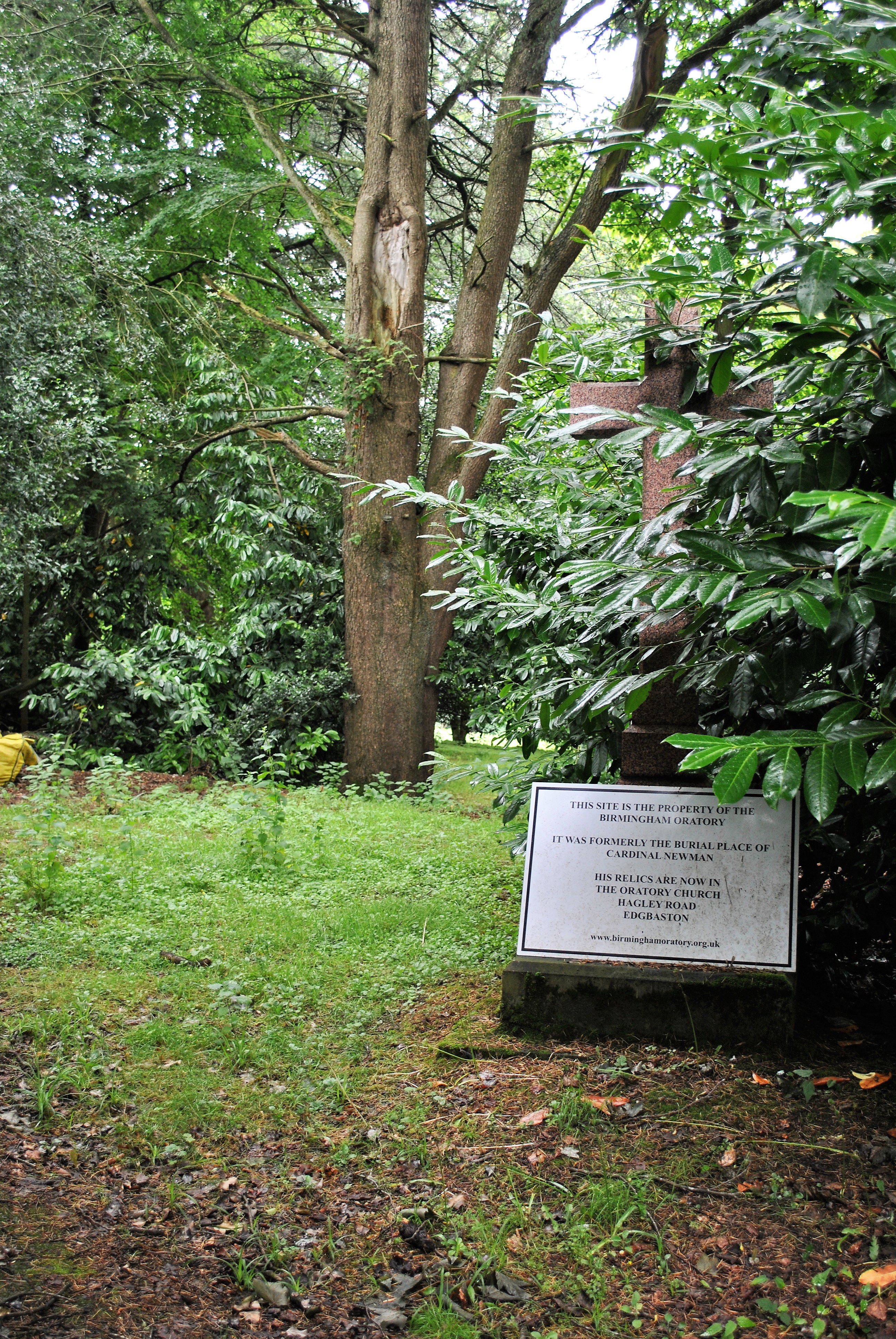BURIED TOGETHER
Partner Ambrose St. John, buried together
Queer Places:
University of Oxford, Oxford, Oxfordshire OX1 3PA
80 Old Broad St, London EC2M 1QT, UK
Newman House, 52 Ham St, Richmond TW10 7HT, UK
17 Southampton Pl, Holborn, London WC1A 2AJ, UK
London Oratory, 24-25 King William St, Candlewick, London EC4R, UK
Brompton Oratory, Brompton Rd, Knightsbridge, London SW7 2RP, UK
Oratory House, Birmingham B45 8, UK
 John Henry Newman, Cong. Orat. (21 February 1801 – 11 August 1890) was an Anglican
priest, poet and theologian, and later a Catholic cardinal, who was an important
and controversial figure in the religious history of England in the 19th
century. He was known nationally by the mid-1830s.[1]
John Henry Newman, Cong. Orat. (21 February 1801 – 11 August 1890) was an Anglican
priest, poet and theologian, and later a Catholic cardinal, who was an important
and controversial figure in the religious history of England in the 19th
century. He was known nationally by the mid-1830s.[1]
Originally an evangelical Oxford University academic and priest in
the Church of England, Newman then became drawn to the high-church
tradition of Anglicanism. He became known as a leader of, and an able
polemicist for, the Oxford Movement, an influential and controversial
grouping of Anglicans who wished to return to the Church of England many
Catholic beliefs and liturgical rituals from before the
English Reformation. In this the movement had some success. In 1845 Newman,
joined by some but not all of his followers, officially left the Church of
England and his teaching post at Oxford University and was received into the
Catholic Church. He was quickly ordained as a priest and continued as an
influential religious leader, based in Birmingham. In 1879, he was created a
cardinal by Pope Leo XIII in
recognition of his services to the cause of the Catholic Church in England. He
was instrumental in the founding of the Catholic University of Ireland which
evolved into University College Dublin,[2] today the largest university in Ireland.
Newman was also
a literary figure of note: his major writings including the ''Tracts for the
Times'' (1833–1841), his autobiography ''Apologia Pro Vita Sua''
(1865–1866), the ''Grammar of Assent'' (1870), and the poem ''The Dream of Gerontius'' (1865), which was
set to music in 1900 by Edward Elgar. He wrote
the popular hymns "Lead, Kindly Light" and "Praise to the Holiest in the
Height" (taken from ''Gerontius'').


Cardinal Newman and Father St. John's grave site
Newman's beatification was
officially proclaimed by Pope Benedict XVI on 19 September 2010 during his
visit to the United
Kingdom. His canonisation is
dependent on the documentation of additional miracles attributed to his
intercession.
After an illness, Newman
returned to England and lived at the oratory until his death, making occasional
visits to London and chiefly to his old friend Richard William Church, now Dean of St Paul's. As a cardinal, Newman published nothing
beyond a preface to a work by Arthur Wollaston Hutton on the Anglican
ministry (1879) and an article "On the Inspiration of Scripture" in ''The
Nineteenth Century'' (February 1884).
From the latter half of 1886,
Newman's health began to fail, and he celebrated Mass for the last time on
Christmas Day in 1889. On 11 August 1890 he died of
pneumonia at the Birmingham Oratory. Eight days later his body was buried
alongside Ambrose St. John in the cemetery at Rednal Hill, Birmingham,
at the country house of the Oratory. At the time of his death he had been
Protodeacon of the Holy Roman Church.
In accordance with his express
wishes, Newman was buried in the grave of his lifelong friend
Ambrose St.
John. The pall over the coffin bore the motto that Newman
adopted for use as a cardinal, ''Cor ad cor loquitur'' ("Heart speaks to
heart"),[3] which William Barry, writing in the ''Catholic
Encyclopedia'' (1913), traces to Francis de Sales and sees as revealing
the secret of Newman's "eloquence, unaffected, graceful, tender, and
penetrating". Ambrose St. John had become a Roman Catholic at
around the same time as Newman, and the two men have a joint memorial stone
inscribed with the motto Newman had chosen, ''Ex umbris et imaginibus in
veritatem'' ("Out of shadows and phantasms into the truth"),[4] which Barry traces to Plato's allegory of
the cave.
On 27 February 1891, Newman's estate was
probated at £4,206.
Newman experienced intense male friendships, the
first with Richard Hurrell Froude (1803–1836), the longest with Ambrose St
John (1815–1875), who shared communitarian life with Newman for 32 years
starting in 1843 (when St John was 28).[5] Newman wrote after St
John's death: "I have ever thought no bereavement was equal to that of a
husband's or a wife's, but I feel it difficult to believe that any can be
greater, or any one's sorrow greater, than mine".[6] He
directed that he be buried in the same grave as St. John: "I wish, with all my
heart, to be buried in Fr Ambrose St John's grave – and I give this as my
last, my imperative will".[7]
In a September 2010
television documentary, "The Trouble with the Pope",[8] Peter Tatchell discussed
Newman's underlying sexuality, citing his close friendship with Ambrose St John
and entries in Newman's diaries describing their intense love for each
other.[9][10][11] Alan Bray, however, in his
2003 book ''The Friend'',[12] saw the bond between the two men as "entirely spiritual",[13] noting that Newman, when
speaking of St John, echoes the language of John's
gospel. Shortly after St John's death, Bray adds, Newman
recorded "a conversation between them before St John lost his speech in those
final days. He expressed his hope, Newman wrote, that during his whole priestly
life he had not committed one mortal sin. For men of their time and culture
that statement is definitive. ...Newman's burial with Ambrose St John cannot be
detached from his understanding of the place of friendship in Christian belief
or its long history". Bray cites numerous examples of friends being buried
together. Newman's burial with St John was not unusual at
the time and did not draw contemporary comment.[14]
My published books:


BACK TO HOME PAGE

- https://en.wikipedia.org/wiki/John_Henry_Newman
- Rossini, Gill. Same Sex Love 1700-1957: A History and Research
Guide . Pen and Sword. Edizione del Kindle.
 John Henry Newman, Cong. Orat. (21 February 1801 – 11 August 1890) was an Anglican
priest, poet and theologian, and later a Catholic cardinal, who was an important
and controversial figure in the religious history of England in the 19th
century. He was known nationally by the mid-1830s.[1]
John Henry Newman, Cong. Orat. (21 February 1801 – 11 August 1890) was an Anglican
priest, poet and theologian, and later a Catholic cardinal, who was an important
and controversial figure in the religious history of England in the 19th
century. He was known nationally by the mid-1830s.[1]


